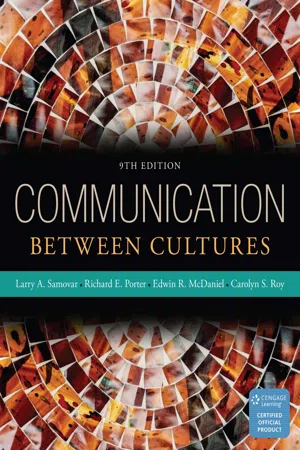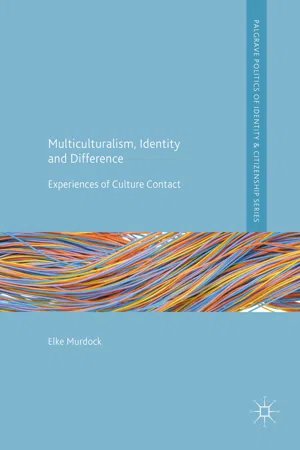Social Sciences
Cultural Identity
Cultural identity refers to the sense of belonging and attachment that individuals have to a particular cultural group. It encompasses the customs, traditions, beliefs, and values that shape a person's self-perception and how they relate to others. Cultural identity is influenced by factors such as nationality, ethnicity, language, religion, and social norms, and it plays a significant role in shaping individual and collective identities.
Written by Perlego with AI-assistance
Related key terms
1 of 5
11 Key excerpts on "Cultural Identity"
- eBook - PDF
- Larry Samovar, Richard Porter, Edwin McDaniel, Carolyn Roy(Authors)
- 2016(Publication Date)
- Cengage Learning EMEA(Publisher)
For instance, Tracy finds identity to be both inclusive and contradictory: “ Identities, then, are best thought of as stable features of persons that exist prior to any particular situation and as dynamic and situated accomplish-ments, enacted through talk, changing from one occasion to the next. Similarly, iden-tities are social categories and are personal and unique. ” 1 Ting-Toomey echoes this inclusive nature when she considers iden-tity to be the “ reflective self-conception or self-image that we derive from our family, gender, cultural, ethnic and individual socialization processes. Identity basically refers to the reflective views of ourselves and other perceptions of our self-images. ” 2 These two definitions treat identity in a broad sense, but some communication scholars address “ Cultural Identity ” more specifically. For instance, Fong contends, “ culture and Cultural Identity in the study of intercultural relations have become umbrella terms that subsume racial and ethnic identity. ” 3 Fong goes on to define Cultural Identity as “ the identification of commu-nications of a shared system of symbolic verbal and nonverbal behavior that are meaningful to group members who have a sense of belonging and who share traditions, heritage, language, and similar norms of appropriate behavior. Cultural Identity is a social construction. ” 4 Cultural Identity for Ting-Toomey and Chung is “ the emotional significance that we attach to our sense of belonging or affiliation with the larger culture. ” 5 Klyukanov sees Cultural Identity as “ membership in a group in which all people share the same symbolic meanings. ” 6 Dervin defines Cultural Identity as “ what we construct whenever we are in contact with other human beings — regardless of the fact that they are from the same ‘ environment ’ or not. ” 7 This series of definitions is not an attempt to con-fuse you. - eBook - PDF
- Margaret Wetherell, Chandra Talpade Mohanty, Margaret Wetherell, Chandra Talpade Mohanty, SAGE Publications Ltd(Authors)
- 2010(Publication Date)
- SAGE Publications Ltd(Publisher)
In order to grasp the increasingly dynamic nature of cultural processes and the manner in which they reflect the multiplica-tion and hybridization of cultural identities of groups and individuals alike, anthropology and the social sciences generally are badly in need of a multidimensional concept of iden-tity. Although some argue that the concept of identity is inadequate for the analysis of complex cultural relationships, over the years it has become part and parcel of political discourses based on, inter alia, non-western marginality, indigenousness, regional loca-tion and immigrant status. For that reason, too, the concept of identity is unlikely to disappear from popular discourses even if social scientists decide to substitute, for example, a multidimensional concept of ‘self’ for the allegedly outdated concept of identity. Hence it is important to scrutinize different dimensions of identity and separate analytically their shifting meanings in aca-demic and popular discourses. Before doing so, however, it is essential to provide a brief history of identity in anthropology, beginning with the culture and personality school. Subsequently, Erikson’s notion of ego-identity will be discussed in order to understand its later extension to the social and Cultural Identity of groups. This shift was paralleled by the emergence of symbolic anthropology, which generated an ethnopsychological debate about intercul-tural notions of the self. In the 1970s, con-structions of gender, ethnicity and national identity also dominated the anthropological agenda, before the rise of postmodernism and globalization led to a more dynamic conception of culture and also of identity. Identity was gradually replaced by the notion of identifications, which never occur singu-larly but only in multiple form. - eBook - PDF
- Warren Kidd, Alison Teagle(Authors)
- 2012(Publication Date)
- Bloomsbury Academic(Publisher)
They are also fundamental to sociology in general and sociological theories in particular. The study of culture is therefore vital to sociology, and to our lives as a whole. Culture is part and parcel of all that we do, all that we are, and all that we can and might become. We shall return later to consider different attempts to define culture within sociology and other disciplines. WHAT IS IDENTITY? If culture is how we behave as a member of a group, then the word ‘identity’ relates to how we think about ourselves as people, how we think about other people around us, and what we imagine others think of us. ‘Identity’ means being able to ‘fix’ or ‘figure out’ who we are as people. Identity can be expressed through culture. 8 Culture and Identity Exercise 2.2 Before reading any further, describe yourself in 100 words as you would to a stranger. K U This should be an informal introduction, as if you were meeting someone for the first time. How have you defined yourself? Identify which characteristics are biological in nature (gender, age, appearance). Have you used any geographical characteristics to identify your-self (where you live, nationality, where you were born)? Have you referred to interests, leisure activities, employment or personal qualities? Any links to status, your role in a family, your marital status? What you have not mentioned is perhaps as important as what you have. Consider why some areas were omitted. Do you not see yourself in that way? Exercise 2.3 Using the internet, find pictures of five different youth cultural groups – such as U I skinheads, heavy metal, indie-kids, nu-metal, punk, hip-hop, emo and so on. For each An picture, describe how you think they see themselves – what you think their identity is, based on the cultural groups to which they belong. Consider to what extent their identity differs from yours. - eBook - PDF
Culture and Politics
A Reader
- NA NA(Author)
- 2016(Publication Date)
- Palgrave Macmillan(Publisher)
Shared identities mean that people see themselves as similar to some people and different from others and are open to potential mobilization on the basis of these differences. What an emphasis on identity stresses, once again, is that the relevant critical aspects of cultural similarity and difference are defined in specific political con- texts. It is also the case that often what people believe they share may be at odds with reality because perceptions of cultural homogeneity overemphasize what is actually shared, minimizing within-group while stressing between-group differ- ences. In this dynamic, in-group conformity pressures will lead people both to selectively perceive greater within-group homogeneity on critical characteristics than actually exists and to generate greater actual homogeneity and group con- formity in situations where perceived threats to the culture are great. Distinguishing Culture from Other Concepts Some uses of the concept of culture, such as much of the early work on national character, defined culture so broadly as to include society, personality, values, and institutions. In fact, nothing was excluded. 23 The very broad use of the concept of culture is also seen among social scientists emphasizing culture as a source of the social integration of a society. This perspective, probably clearest in func- tional theory in British social anthropology, would use culture to refer both to distinct elements of social organization and to the "fit" between different parts of a cultural system and the integration of the whole. The problem here is not the concept of culture but the way it is used. As noted above, the current anthro- pological focus is on culture meaning systems distinct from social structure and behavior. - eBook - PDF
Differences, Similarities and Meanings
Semiotic Investigations of Contemporary Communication Phenomena
- Nicolae-Sorin Drăgan(Author)
- 2021(Publication Date)
- De Gruyter Mouton(Publisher)
natural relation of the self with these three sites is fractured. In this context, is culture to be considered part of the external world? Or, are we to say with Lot-man (1990: 223) “ We are within [culture], but it – all of it – is within us ” ? We can say therefore that Cultural Identity is an intrinsic aspect of personal iden-tity, and this relation leads us to point out one of the key correlates of identity: the sense of belonging . The reflective processual identity that we will be refer-ring to is not about being, but about becoming and belonging. Our becoming constantly questions our belonging. After the seminal works on the topic of narrative identity in the late 1980 ’ s and early 1990 ’ s in different disciplines (e.g.: philosophy, Ricoeur 1984, 1991; psychology, McAdams 1988, 1996; social sciences, Sommers 1992, 1994), narra-tive identity became an interdisciplinary field with deep roots in psychology, therefore exploring mostly the level of individual narrative identity, with very little having said about the cultural or social levels (Sommers being an excep-tion). Thus, at the level of the individual, . . . narrative identity is an internalized and evolving story of the self that provides a per-son ’ s life with some semblance of unity, purpose, and meaning. Complete with setting, scenes, characters, plots, and themes, narrative identity combines a person ’ s reconstruc-tion of his or her personal past with an imagined future in order to provide a subjective historical account of one ’ s own development, an instrumental explanation of a person ’ s most important commitments in the realms of work and love, and a moral justification of who a person was, is, and will be. - eBook - ePub
Multiculturalism, Identity and Difference
Experiences of Culture Contact
- Elke Murdock(Author)
- 2016(Publication Date)
- Palgrave Macmillan(Publisher)
1991 ) distinguished between independent and interdependent cultures. The key difference here is that within individualistic cultures, which are usually associated with the Western life-style, individuals want to distinguish themselves. Within Eastern cultures, blending in with the group is more important. The relationship between culture and the self will be discussed later in this chapter.Aspects of Identity
Theories of identity and the self are key concepts of psychology and some aspects of identity construal have already been mentioned in the course of the chapter. For an overview of key approaches and concepts of self and identity I would like to refer to Epstein (1973 ), Greve (2000 ) and Filipp and Mayer (2005 ), as a detailed review goes beyond the scope of this book. At this stage I would like to note that the development of self-related knowledge systems (identity) is a life-long process . The sources for and content of self-related knowledge change in the course of development. Self-related information is incorporated in a way that maximizes coherence , consistency across situations and continuity over time, the goal being an increase in self-worth at the affective level and the experience of consistency at the cognitive level. As noted in the previous section, self-enhancement is a core human motivation and has also behavioural consequences. People differ regarding the level and stability of the self-assessments (self-esteem), as well as the level of complexity and organization of the self. People also differ regarding domains included in the self-concept as well as the valence accorded to aspects within the self.In the following section I will highlight some frameworks which address specific aspects of identity formation which are pertinent in a multicultural context. First the question of national identity formation will be addressed, including the persistence of a primordial understanding. This persistence will be explained using the cognitive-experiential framework. The relationship between culture and the self, including the interplay between the individual, interpersonal and group self will be the focus of the final section.As Valsiner (2007 ) noted “The self is a trouble-maker” (p. 1). Epstein (1973 ) asked if there is a need for a self-concept in psychology, as “one can neither see a self-concept nor touch it, an no one has succeeded as yet in adequately describing it as a hypothetical construct” (p. 404). Baumeister (1999 ) also observed that even though most people use I and self many times each day, articulating that understanding is not easy and he observed: “This conceptual elusiveness is one reason that the study of self has proven fiendishly difficult” (p. 1). Using immunology as an analogy, Valsiner (2007 ) defined the self as a general term to describe the myriad of personal-cultural processes that are created through semiotic mediation. As such, the concept of self becomes a frame for viewing unity in the processes of creating personal experiences. The self is not open to direct measurement, as self is a process not an entity—Valsiner speaks of selfing . Direct queries about “your self” are culturalized phenomena. As he explained, “the ‘detection’ of identity is in the mind of the beholder—it is a co-constructive interpretative act” (Valsiner, 1997 - eBook - PDF
- Guido Alpa(Author)
- 2024(Publication Date)
- Hart Publishing(Publisher)
8 ‘Identity’: A Multifaceted Self culture, his or her way of dressing, eating, observing the rules of ceremonial, etiquette and manners. Law regulates his or her affections, aspirations, intimate relationships. Here, unlike the other sciences, which construct identity on the basis of their constantly evolving categories, which are verifiable and susceptible to rectification, modification and alteration, 15 and with margins of approxima- tion, law constructs identity with binding categories: the individual cannot escape them except with the authorization, or at any rate the intervention, of authority. Law prescribes a person’s way of being and living. This consideration familiar to jurists, and to scientists concerned with legal anthropology, eludes sociologists who study the ways in which people construct themselves, as if the individual will alone could exhaust the factors that sculpt identity. Every individual has a ‘future behind him’, 16 to use Hanna Arendt’s expres- sion, because his or her past that sculpts his or her present has been constructed by the ordering categories of law. Identity then turns from fact to precept, from a real world as interpreted by the social sciences into an imaginary world constructed by norms. In this world too – according to different conceptions of law – one encounters the person in many dimensions: from the statement that must be interpreted according to canons established by law to the human being in his corporeity, from the abstract concept to concrete life. Life and rules – to use an expression dear to Stefano Rodotà – are marked by law. The relationships an individual has with others are also governed and shaped by law: family, association, community and authority law relationships. Not only the person as ‘self’, but also the self and the other, the self and others, are governed by law. - eBook - PDF
Identity Process Theory
Identity, Social Action and Social Change
- Rusi Jaspal, Glynis M. Breakwell(Authors)
- 2014(Publication Date)
- Cambridge University Press(Publisher)
It encompasses both collective and indi- vidual elements of the self. The potential to theorize the relationship between the individual and the social and its relation to human action has made identity a very popular concept among social psychologists. It has been considered in terms of its role and its relation to intergroup behav- ior, politicization and action (Mead, 1934; Reicher, 2004; Simon, 2004; Tajfel, 1974, 1981), or in terms of how its content is constructed, devel- oped, challenged and changed (Breakwell, 1986; Deaux, 1992; Duveen, 2001). Whatever the angle from which identity is studied, it is considered the social psychological concept that reflects the ways in which people understand their social environment and their place in it. In other words it is the concept that allows us to discuss how society “continues itself within individuals” (Doise, 1997). I have argued elsewhere that identity is a social representation of the self that reflects and objectifies people’s understanding of who they are and what they can claim to be, along with their own aspirations within the framework of their social environment (Chryssochoou, 2003). In order to develop a concept of identity that facilitates an understanding of the relationship between identifications and different behaviors (individual and collective), identity needs to be theorized at multiple levels of analysis (Breakwell, 1986, 2010a; Deaux, 2006; Doise, 1986, 2012; Verkuyten, 2005) and both as a product and a 3 Talking about identity as a structure has not, however, acquired the unanimous agree- ment of the researchers working with this concept. For example, Turner and Onorato (1999, p. 33) suggest that we should look at the self as a process “a functional property of certain categories.” In this perspective a category becomes a self-category not because of the way it is stored but because of the way it is used. Identity structure is not regarded as fixed or immutable. - Available until 15 Jan |Learn more
International Social Work
Social Problems, Cultural Issues and Social Work Education
- Stefan Borrmann, Michael Klassen, Christian Spatscheck, Stefan Borrmann, Michael Klassen, Christian Spatscheck(Authors)
- 2007(Publication Date)
- Verlag Barbara Budrich(Publisher)
How to connect students with that struggle inviting them to think about where they see themselves as agents and targets, and finally empowering them in the positive aspects of their identity are impor-tant opportunities. 5. Conclusion Swami Prajnanpad urged people to embrace their own uniqueness, while respecting what is unique in others (Welwood, 2003). With increased global-ization there are many more opportunities for cross-cultural fertilizations. This also brings greater opportunities for cultural misunderstandings as well as abuses of power and privilege. The use of relationship is fundamental to social work practice throughout the world. Relationships involve individuals, families, groups and communi-ties. Social identity is a construct that helps to explicate the complexities of such social interactions and integrates social phenomena with personal iden-tity. We presented a model that attempts to map the complexities of social The complexity of multidimensional social identity development 93 identity. As with all maps, our model should not be mistaken for the territory. Human identity and interaction will always present puzzles and raise ques-tions to which no model will ever adequately respond. Yet the quest for un-derstanding ourselves and others will continue. References Adams, M.; Bell, L.A.; Griffin, P. (1997) (eds.). Teaching for diversity and social justice: A sourcebook. New York: Routledge. Appiah, Kiwame (2006). The case for contamination. The New York Times Magazine Section, Jan. 1, 30-37, and 52. Burdsey, D.; Chappell, R. (2004). Soldiers, sashes and shamrocks: Football and social identity in Scotland and Northen Ireland. Sociology of sports online, http://physed.otago.ac.nz/sosol/v6i11.html, retrieved May 15, 2006. Cass, V.C. (1979). Homosexual identity foundation: A theoretical model. Journal of Homosexuality , 413/219-235. Cooly, C.H. (1922). Human nature and the social order. New York: Scribner. - eBook - ePub
Redefining Culture
Perspectives Across the Disciplines
- John R. Baldwin, Sandra L. Faulkner, Michael L. Hecht, Sheryl L. Lindsley, John R. Baldwin, Sandra L. Faulkner, Michael L. Hecht, Sheryl L. Lindsley(Authors)
- 2006(Publication Date)
- Routledge(Publisher)
Social Identity Theory. The intergroup perspective has its grounding in Tajfel and Turner’s (1986; Tajfel, 1978) social identity theory (SIT), which was developed out of a desire to explain discriminatory behaviors in comparison with others. The essential underlying concept of SIT is that people have both a personal and a social identity. In certain situations, when group or social identity becomes salient (e.g., intercultural encounters), a person will behave not according to her or his individual belief system or interpersonal belief system, but according to the belief system held by the larger identity group. Here, culture is salient when group-based identities are activated. From a SIT perspective, a situation is “cultural” when the context activates group-based identities and categorization.The three basic principles of SIT are as follows:- Individuals strive to achieve or to maintain positive social identity.
- Positive social identity is based to a large extent on favorable comparisons that can be made between the in-group and some relevant out-groups: The in-group must be perceived as positively differentiated or distinct from the relevant out-groups.
- When social identity is unsatisfactory, individuals strive either to leave their existing group and join some more positively distinct group or to make their existing group more positively distinct. Social identity theory established the basic premises of the intergroup approach by focusing on group membership. SIT did not introduce the construct of identity, but popularized its use in defining culture. In addition, SIT pointed out many of the ways cultures maintain their sense of membership, often by setting one group against another. Reflecting its grounding in concerns about some less pleasant manifestations of culture and cultural practices (e.g., discrimination, stereotyping), SIT has played an important role in setting an agenda for research. In fact, two theories (communication accommodation theory and ethnolinguistic identity theory) have sprung from this conceptual basis to explain further these group processes.
- eBook - ePub
Cross-Cultural Conversation
A New Way of Learning
- Anindita N. Balslev(Author)
- 2019(Publication Date)
- Routledge India(Publisher)
but only if we are prepared to learn to listen to each other and are willing to become partners in a new social adventure. It is only when this conversation will be geared toward comprehending all those experiences where oppression, marginalization and humiliation of one have been intertwined with those of exploitation, domination and arrogance of another in our cultural practices that it can be taken as a visible sign for the dawning of a larger identity. It is difficult to imagine a more moving experience than sharing the stories of various groups concerning how they have interacted with each other in remote and recent history – groups that are formed along the lines of gender, race, religion, ethnicity, nationality and so forth. The “hard” boundaries that previously made the “we and they” divide and the atrocities related to such divisive practices would then begin to lose their luster.Clearly, the scenes of ideological battles keep changing from one phase of history to another. However, in a setting where conversation remains open and earnest among participants coming from divergent backgrounds, there is hardly much room left for either underplaying or radicalizing the presence of diversity in various contexts of social exchange and interactions. In this era of living in an interdependent and interconnected world, when the multiple social identities are increasingly widening with the proliferation of group formations on the basis of a freshly invented range of criteria, we are slowly becoming aware of the fact that a sense for a larger identity is to be respected and vigilantly contained within the complex web of contemporary life – both factual and conceptual. No matter which kinds of group affiliations we have today, none can maintain its pristine distinctness without having to interact with the otherness of the other. To be obsessed by our membership of a single identity group formation is to seek in vain the triumph of the latest forms of tribalism.Regardless of how we construe the idea of human solidarity and envision the sense of a larger identity, these are two sides of the same coin. The process of actual implementation inevitably involves various stages so that the ideas can be adjusted in consonance with the circumstances of our time. Conceptually speaking, fostering human solidarity poses an altogether different kind of challenge today since its construal must reflect the ground realities that have considerably altered. In fact, some of the earlier ideological stances do not any longer seem like worth pursuing in our time. Thus, for example, the one-world slogan, advocated in the not so distant past, has over time been looked at as being covertly abhorrent toward cultural diversity, just as any form of extreme relativism is now found to be unrealistic and unacceptable. Consequently, none of these paradigms are considered as suited for recovering common ground in terms of aspirations, goals and values across cultures or even for taking into account cultural differences in an effective and authentic manner.
Index pages curate the most relevant extracts from our library of academic textbooks. They’ve been created using an in-house natural language model (NLM), each adding context and meaning to key research topics.










